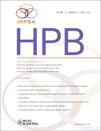Intraoperative portal vein blood flow predicts allograft and patient survival following liver transplantation
This paper is based on a presentation given at the American Hepato-Pancreato-Biliary Association Annual Meeting, 27–30 March 2008, Fort Lauderdale, Florida.
Abstract
Background: We hypothesized that operative variables might predict survival following liver transplantation.
Methods: We examined perioperative variables from 469 liver transplants carried out at the University of Washington during 2003–2006. Logistic regression determined the variables' contributions to survival at 30, 90 and 365 days.
Results: Portal vein blood flow (>1 l/min) was significant to patient survival at 30, 90 and 365 days. Complete reperfusion was only a significant predictor of survival at 30 days. This provided model receiver operating characteristic (ROC) area under the curve (AUC) statistics of 0.93 and 0.87 for 30 and 90 days, respectively. At 365 days, hepatic artery blood flow (>250 ml/min) combined with portal vein blood flow was significantly predictive of survival, with an AUC of 0.74. A subset analysis of 110 transplants demonstrated improved 1-year survival with more aggressive vascular revisions.
Discussion: Portal vein blood flow is a significant predictor of survival after liver transplantation. Initially, the liver's survival is based on portal vein blood flow; however, subsequent biliary problems and patient demise result from both poor portal vein and inadequate hepatic artery blood flow.




